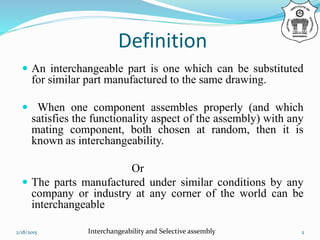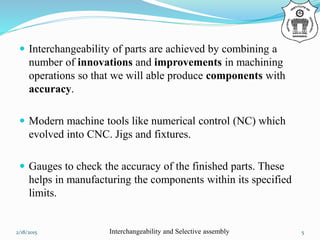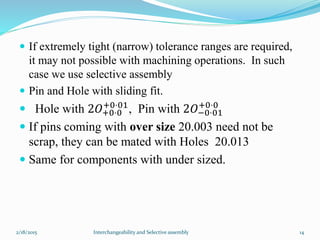Interchangeability & selective assembly
- 1. 2/18/2015 Interchangeability and Selective assembly 1 Chirra Kumara swamy Roll No.143503 M.Tech (MFG) NIT Warangal
- 2. Definition An interchangeable part is one which can be substituted for similar part manufactured to the same drawing. When one component assembles properly (and which satisfies the functionality aspect of the assembly) with any mating component, both chosen at random, then it is known as interchangeability. Or The parts manufactured under similar conditions by any company or industry at any corner of the world can be interchangeable 2/18/2015 Interchangeability and Selective assembly 2
- 3. Before the 18th century production used to be confined to small number of units and the same operator could adjust the mating components to obtain desired fit. Devices such as guns were made one at a time by gunsmith. If single component of a firearm needed a replacement, the entire firearm either had to be sent to an expert gunsmith for custom repairs, or discarded and replaced by another firearm. 2/18/2015 Interchangeability and Selective assembly 3 Historical Background
- 4. Eli Whitney and an early attempt Eli Whitney understood that developing "interchangeable parts" for the firearms of the United States military is important. In July 1801 he built ten guns, all containing the same exact parts and mechanisms, then disassembled them before the United States congress. He placed the parts in a mixed pile and, with help, reassembled all of the firearms right in front of Congress. 2/18/2015 Interchangeability and Selective assembly 4
- 5. Interchangeability of parts are achieved by combining a number of innovations and improvements in machining operations so that we will able produce components with accuracy. Modern machine tools like numerical control (NC) which evolved into CNC. Jigs and fixtures. Gauges to check the accuracy of the finished parts. These helps in manufacturing the components within its specified limits. 2/18/2015 Interchangeability and Selective assembly 5
- 6. If a plot is drawn of the actual dimensions of the similar components produced by a well-controlled machine, it is found to follow Normal distribution. 2/18/2015 Interchangeability and Selective assembly 6 σ= Standard deviation x̄ =mean Σ X/N , f=frequency
- 7. Example we have 100 parts each with a hole and 100 shafts which have to fit into these holes. If we have interchangeability then we can make any one of the 100 shaft & fit it into any hole & be sure that the required fit can be obtained. Any M6 bolt will fit to any M6 nut randomly selected. 2/18/2015 Interchangeability and Selective assembly 7
- 8. The advantages of interchangeability 1. The assembly of mating parts is easier. Since any component picked up from its lot will assemble with any other mating part from another lot without additional fitting and machining. 2. It enhances the production rate. 3. It brings down the assembling cost drastically. 2/18/2015 Interchangeability and Selective assembly 8
- 9. 4. Repairing of existing machines or products is simplified because component parts can be easily replaced. 5. Replacement of worn out parts is easy. 6. Without interchangeability mass production is not possible. 2/18/2015 Interchangeability and Selective assembly 9
- 10. Examples Keys Couplings Pin Joints Screwed Fasteners Gears Clutches 2/18/2015 Interchangeability and Selective assembly 10
- 11. Selective assembly The discussion so far has been in connection with full interchangeability or random assembly in which any component assembles with any other component. Often special cases of accuracy and uniformity arises which might not be satisfied by certain of the fits given under a fully interchangeable system. 2/18/2015 Interchangeability and Selective assembly 11
- 12. for example if a part at its low limit is assembled with the mating part a high limit, the fit so obtained may not fully satisfy the functional requirements of the assembly. also machine capabilities are sometimes not compatible with the requirements of interchangeable assembly. 2/18/2015 Interchangeability and Selective assembly 12
- 13. For selective assembly, components are measured and sorted into groups by dimension, prior to the assembly process. This is done for both mating parts. Consider a bearing assembly Hole with 25+0⋅02 −0⋅02 , Shaft 25−0⋅14 −0⋅10 Clearance should be 0.14mm Randomly if we take 25−0⋅02 and 25−0⋅10 clearance will be 0.08mm Hole and Shaft pairing respctively which gives 0.14mm clearance 24.97 and 24.83, 25.0 and 24.86, 25.02 and 24.88 2/18/2015 Interchangeability and Selective assembly 13
- 14. If extremely tight (narrow) tolerance ranges are required, it may not possible with machining operations. In such case we use selective assembly Pin and Hole with sliding fit. Hole with 2𝑂+0⋅0 +0⋅01 , Pin with 2𝑂−0⋅01 +0⋅0 If pins coming with over size 20.003 need not be scrap, they can be mated with Holes 20.013 Same for components with under sized. 2/18/2015 Interchangeability and Selective assembly 14
- 15. Process capability The minimum toleranced components which can be produced on a machine with more than 99% of acceptability called as process capability 80±0.1 680/1000 accuracy. 80±0.2 910/1000 80±0.3 991/1000 (99%) 80±0.4 993/1000 80±0.6 1000/1000 (100%) 2/18/2015 Interchangeability and Selective assembly 15
- 16. Problem-1For Clearance Fit Hole = 2𝑂+0⋅0 +0⋅1 Shaft = 2𝑂−0⋅15 −0⋅05 Tolerance for both = 0.1mm Maximum clearance = H.L of hole - L.L of shaft = 20.1-(19.85) = 0.25 mm Minimum clearance = L.L of hole - H.L of shaft = 20.0-(19.95) = 0.05 mm Process capability = 0.3 Number of groups = (process capability)/Tolerance = 0.3/0.1=3 Let those groups be denoted by A, B, C 2/18/2015 Interchangeability and Selective assembly 16 Type Hole (mm) Shaft (mm) A 2𝑂+0⋅0 +0⋅1 2𝑂−0⋅15 −0⋅05 B 2𝑂+0⋅1 +0⋅2 2𝑂−0⋅05 +0⋅05 C 2𝑂+0⋅2 +0⋅3 2𝑂+0⋅05 +0⋅15
- 17. Group C holes with, Group C shaft Hole Tolerance =0.1mm Shaft Tolerance =0.1mm Type of fit required is clearance. Maximum clearance = H.L of hole - L.L of shaft = 20.3-20.05 = 0.25mm Minimum clearance = L.L of hole - H.L of shaft = 20.2-20.15 = 0.05mm 2/18/2015 Interchangeability and Selective assembly 17
- 18. Advantages There is a larger number of acceptable parts as original tolerances are greater This in turn allows the manufacture of cheaper parts as less will be consigned to the waste bin. Selective Assembly assures better and more accurate assembly of parts by insuring closer tolerances between the mating parts. Rise the quality and lower manufacturing costs by avoiding tight tolerances. Reduces the rejection rate (scrap rate) 2/18/2015 Interchangeability and Selective assembly 18
- 19. Limitations During usage of the assembly if one component fails, first we need manual of assembly and identify the group to which failure component belongs to and search the component in spare parts. By focusing on the fit between mating parts, rather than the absolute size of each component so there will small deviation in size of component. 2/18/2015 Interchangeability and Selective assembly 19
- 20. References 1. A text book of production engineering By P. C. Sharma 2. Metrology & Measurement By Bewoor 3. http://en.wikipedia.org/wiki/Interchangeabparts 2/18/2015 Interchangeability and Selective assembly 20



















